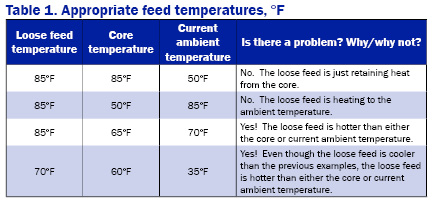
Is your silage too hot to handle? – Dr. Michelle Windle, Vita Plus
 By Dr. Michelle Windle, Vita Plus forage products and dairy technical service specialist
By Dr. Michelle Windle, Vita Plus forage products and dairy technical service specialistAny living organism produces heat when it does work. As a microbiologist, whenever I see heat, I question, “Who is doing the work?” and “What is being done?” The organisms can either enhance or degrade silage quality.
Internal temperature, the temperature 18 inches into the silage, reflects both upfront fermentation efficiency and the ambient temperature at ensiling. During the upfront fermentation, microorganisms produce acids that lower silage pH and preserve it during storage and feedout.
In well-packed, promptly sealed silos, the internal temperature shouldn’t exceed 10 to 15 degrees F above the ambient temperature at the time of ensiling. Silos retain ambient heat from the time of ensiling and this influences core temperature interpretation later. For example, if the core temperature at the time of assessment is 85°F, and the temperature at ensiling was 45°F, the silage heated 40°F – that’s too high. Excessive heat production decreases energy content, dry matter and overall silage quality. However, if the temperature on the day of ensiling was 75°F, the silage only heated 10°F and this is normal and healthy.
Dry or poorly-packed silages contain many oxygen pockets, leaving the silage susceptible to excessive heating during fermentation and spoilage. In the prolonged presence of oxygen, aerobic bacteria present in the crop are enabled to thrive, produce heat and degrade silage quality.
Once sealed in a silo, the low pH in fermented feeds cause the aerobic bacteria to go dormant. However, once oxygen re-enters the silo, such as during feedout or due to silo damage, spoilage yeasts are able to grow. Spoilage yeasts increase silage pH, paving the way for aerobic bacteria and molds to produce heat and degrade silage quality.

| Category: |
Forage Foundations Forage storage and management |

